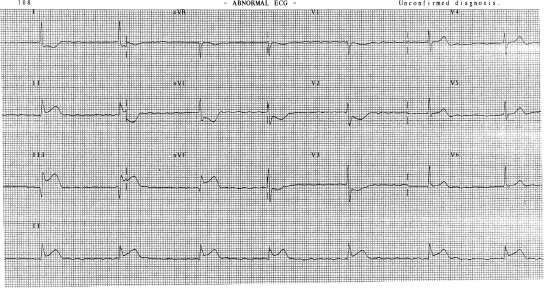Abstract
This literature review illustrates the various ways images are used in teaching and the evidence appertaining to it and advice regarding permissions and use. Four databases were searched, 23 papers were retained out of 135 abstracts found for the study. Images are frequently used to motivate an audience to listen to a lecture or to note key medical findings. Images can promote observation skills when linked with learning outcomes, but the timing and relevance of the images is important – it appears they must be congruent with the dialogue. Student reflection can be encouraged by asking students to actually draw their own impressions of a course as an integral part of course feedback. Careful structured use of images improve attention, cognition, reflection and possibly memory retention.
Images can have many roles in teaching and are often inserted into Power-point presentations without thought to their effect, whether or not it is adding to the ‘story’, and when many images are often poor quality. Images have power in their own right to communicate and so should be used accordingly to enhance and create interest with less bulleted text. A few key words on a high quality image are the ‘stage prompt’ for both speaker and audience.
Definition of images
An image may be an illustration that has some resemblance to the topic under discussion or it can be a graphic representation such as a chart, graph or diagram.1
Methodology
A literature search was carried out using EBSCO as the host database, searching for the phrase ‘use images teaching’ within the Medline, Psycho-info and Psychology and Behavioural Science databases. Papers which were written in English and available in full text were retained. The searches produced 118 responses in Medline and 20 in psych-info and psychology. All abstracts were read and 25 papers were retained in full text for the study. The subsequent paragraph titles arose from topics identified within the literature review.
Images as ‘icebreakers’
Images are frequently used as ‘icebreakers’ at the start of a presentation to motivate an audience to listen and pay attention. The image is chosen to promote the relevance of the lecture content ‘perhaps it might happen to me’, which is important in adult learning.2
A really interesting picture may motivate students to pay more attention and might even create a ‘light bulb moment’ which students will always remember. A ‘light bulb moment’ is a vivid imprinted memory of a particular event - for example what someone was doing when President Kennedy was assassinated. The way we see and store images is known as picture perception and it is an important facet of memory. The visual cortex processes the information from the retina and can recognize patterns in less than 0.1 seconds. The picture we view is a ‘flat’ image, but the mind then conjures what the person/animal or object is really like. For example, a picture of a wolfhound does not tell you it has a wiry coat, but the brain ‘tells’ you it has. This is known as the resemblance theory. Constructivist theory2 suggests the picture does not tell its own story but that we construct the meaning on top of our memories.
Images may act as a focus of interest
Many teachers use a famous painting or a picture of equipment – something to illustrate the objectives of a lecture. It can be difficult to obtain permission for images of real patients and it is often easier (and less expensive) to obtain permission for photographs of famous paintings. One superb picture might be the only illustration necessary for an entire lecture. Martin3 used a picture of the two sides of a single coin to create an entire lesson related to critical thinking. Power-point presentations can limit the dialogue and creativity of an oral presentation, and dialogue is often created to ‘fit’ a Power-point presentation rather than considering whether or not slides are really necessary.4,5
Images may help observation skills
Frequently, slides in the Advanced Trauma Life Support course material are used to gain attention and to test observation skills by the candidates. Inexperienced students may need to be directed as to specific areas for these observations; to notice if a patient's colour is poor, if there is soot around nostrils or facial swelling. Images can promote observation skills perhaps by highlighting the position of a patient, their distress or something in the background. Gombrich6 illustrates this clearly with his description of the many layers of meaning in the engravings of a baptismal font in Liège (Belgium). The figures of oxen which create the plinth, actually represent a biblical story which the artist was asked to use when making the font.
The wonderful painting ‘Death of a bride’ by Thomas Jones Barker could allow students to try and describe the physical signs of the lady on the bed, noting pallor, limp hands and closed eyes. However, an experienced audience might extend awareness to the fact her husband is not touching her, instead leaning with his head bowed on his arms, allowing them to construe the lady has died. When an image is used as an explanatory aid, it may help retention of information. Video followed by practice seemed to aid retention in older adults.7 The study involved 60 people divided into two age groups, 30 were aged 17–24 years and 30 aged 64–74 years. Both groups received instruction to operate a blood glucose machine, either by using a manual or using a video. Older people performed better with the video, but the younger group showed no difference. Retention was also tested at two weeks after the training and retention was greater in the younger group.
Images as metaphors
Cosgrove8 described the use of images of a toy train-set to illustrate oxygen delivery to tissues. Physiotherapy students in the study group obtained higher marks in MCQ papers following the lecture, compared with a control group. This suggests the imagery significantly increased understanding of the topic and possibly memory retention as well. Figure 1 illustrates the image of motor sport competitors starting a race; it is the metaphorical representation of the teams being ready in a major incident, before confusion and maybe chaos ensue.
Figure 1.

Use of image of motor sport as a metaphor for major incident planning
Images in lectures can act as ‘signposts’
Images can play an important role in guiding students through the narrative of the presentation which can be particularly important in long complicated topics. A lecture is a ‘story’, so images can mark the beginning, any changes in direction and closure. Cleverly linked images help emphasize the learning objectives.6 An image may also remind a lecturer to pause, recap and summarize key points or be a reminder to the lecturer of their time management by utilizing a key picture every 10–15 minutes or half way through a presentation. Subtle use of contrast changes can also mark transitions from one area of a lecture to another.5,6 If slides contain images of people and text, the image should be orientated toward any text so the viewer's eye is not drawn away from the subject matter.5,6
Pattern recognition
Many aspects of medicine depend on pattern recognition typically, ECGs, X-rays, and ultrasound. Illustrations can be effective if they allow learners to link information and interpret it, indeed Azer9 suggests that images should be carefully linked to the lesson objectives. If the objective of a lecture is to discuss ‘fits, faints and funny turns’, then video clips illustrating examples may be really helpful rather than static images. The prior knowledge of learners may mediate the effect of individual learning from graphics. PACS images can form part of sophisticated radiological teaching for individuals, groups, multiple sites and home use.10 Images such as the ECG in Figure 2 allow pattern recognition of types of myocardial infarct, and images of serial ECGS can explain the chronological changing pattern as an infarct develops, and related discussion such as underlying pathology.
Figure 2.
Abnormal ECG showing typical Inferior myocardial infarct
Timing of use of images and image quality
Memory for pictures may be better than for words11 and this fits with the dual code theory that images are stored via a different pathway to auditory information in the brain.12 The dual coding theory of memory proposes that memory of verbal information is increased if pictures are used which match the verbal content of a lecture. Baddeley13 suggests working memory is a two-part process, visuospatial and phonological involving different loops with the different memory pathways activated simultaneously, leaving different memory traces. Memory of verbal information is increased if the image portrayed was relevant to the topic.14 Pictures only help memory if the timing of the spoken word matched the introduction of the image, in addition there appeared to be an approximate relationship between the degree of realizm of the image and learning.11 The definitive nature of the visual imagery seems to be the key to comprehension, problem solving, memory and retrieval of information.12 Cendan et al (2004) suggested that haptic teaching must also be synchronous with visual imagery to promote memory.15
Cartoon images can add humour
Cartoons can be particularly useful if a lecturer knows he or she is not good at telling jokes or making quips. It is often safer because the use of a planned image should be less likely to cause offense than an ‘off the cuff’ remark. Cartoons can also add humour or focus.16 People tend to be quite polarized in their opinions regarding cartoons. A cartoon may act as a stimulus to promote discussion and higher order thinking. Humour can create a more relaxed learning which promotes learning.17 Cassaday et al (2002) indicates relaxed conditions promote learning. If students are stimulated to laugh or smile, a teacher knows the students' attention has been captured, however briefly. Cartoons might also be used to reduce stress and boredom, or exaggerate a particular aspect of a topic.
Images as concept maps
Concept maps are any method of presenting information in a structured format; this can include, diagrams, spreadsheets, graphs, mind maps or pictures. Mind maps were a technique designed in 1972, and are extensively used in schools and tertiary education.18 The concept map framework allows a visual structure of the dialogue, illustrating the important concepts and aiding understanding. It offers an alternative way of illustrating a topic which may help different types of learners. Referring back to the mind map also allows students to catch up after ‘micro sleeps.’ It can be used to promote discussion, to differentiate between levels of learner, to increase creativity and can help a lecturer to manage time. A lecture can be stopped at an appropriate concept and the topic can easily be picked up at a subsequent lecture or tutorial. A concept map can take many different forms, and mnemonics are commonly used to provide a list of related concepts.
For example: A topic for a teaching seminar might be the symptoms and signs of opiate withdrawal in a neonate and Figure 3 shows the use of a mnemonic to aid memory used as a concept map.
Figure 3.
Mnemonic used for topic teaching on opiate withdrawal in neonate
The ancient Greeks are reported to have used mnemonics extensively in order to memorize the long Greek tragedies. Some people use mental mnemonics remembering information relating to places, others will use visual mnemonics to aid memory and whilst this does not help everyone, it is another tool in the armoury of an educator. Concept maps may link large overlying concepts or quite specific ones as illustrated here. They allow students to add new knowledge to a known structure which aids short term working memory. The learning process can be made more meaningful and creative by extending discussion in some or all of the areas. Medicine is ideal for this as the degree of discussion can vary according to the experience and nature of the audience, can be technical or case-based. This fits with educational theory2; learning is relevant, motivation is high, the knowledge structure is enhanced. This encourages an orderly sequence of iteration of work which can then move from short- to long-term memory.12
Images can ‘brighten’ a dull topic
The quality of the images appears to be very important and natural colours are remembered more readily than unnatural.19 It is worth getting expert help editing pictures to maximize their effect.9 In Click's study,20 people reading newspapers prefer colour images and colour seemed to be significant in helping to recall facts. Colour photographs are remembered better than black and white.21 Memory might be increased due to greater attentiveness, more realistic colours seem to aid memory more than faded colours or colours which do not ‘fit’ with a remembered image.22
Images can be used to encourage student reflection on their learning
Candidates training to become resuscitation instructors attend a 3-day instructor training course called the generic instructor course – GIC (GIC). Resuscitation instructors working within the clinical skills department of Southampton Medical School have been encouraging candidates on the GIC to draw pictures of their impression of the role of an instructor. The task is set at the end of the third day, the final day of the course. At this time the educator of the course talks to them about their future training and what they need to do after the course to become full Resuscitation Council UK instructors. Candidates break into their groups and draw. The illustrations are many and varied, and reflect considerable insight and creativity. The impression of the author is that this activity increases group cohesiveness, helps the candidates to unwind after an extremely intensive course and they leave to go home refreshed. The results have been extremely creative (Figures 4, 5, 6). A vote is taken on the best result by the faculty and the medical illustration department in Southampton enhances and enlarges the pictures to form full length posters which decorate the skills department. The images give remarkable insight into the candidate perception of the resuscitation instructor role. Ericsson23 suggests reflection on thought processes and methods is an aid to expertise through metacognition. Another example which does not involve projected images is the use of body painting. Body painting has been used successfully for clinical anatomy and evokes strong visual memories as well as being fun. When used in this way, it reaches to kinaesthetic learners in a way few other mediums can and has been shown to improve retention of anatomy.24
Figure 4.
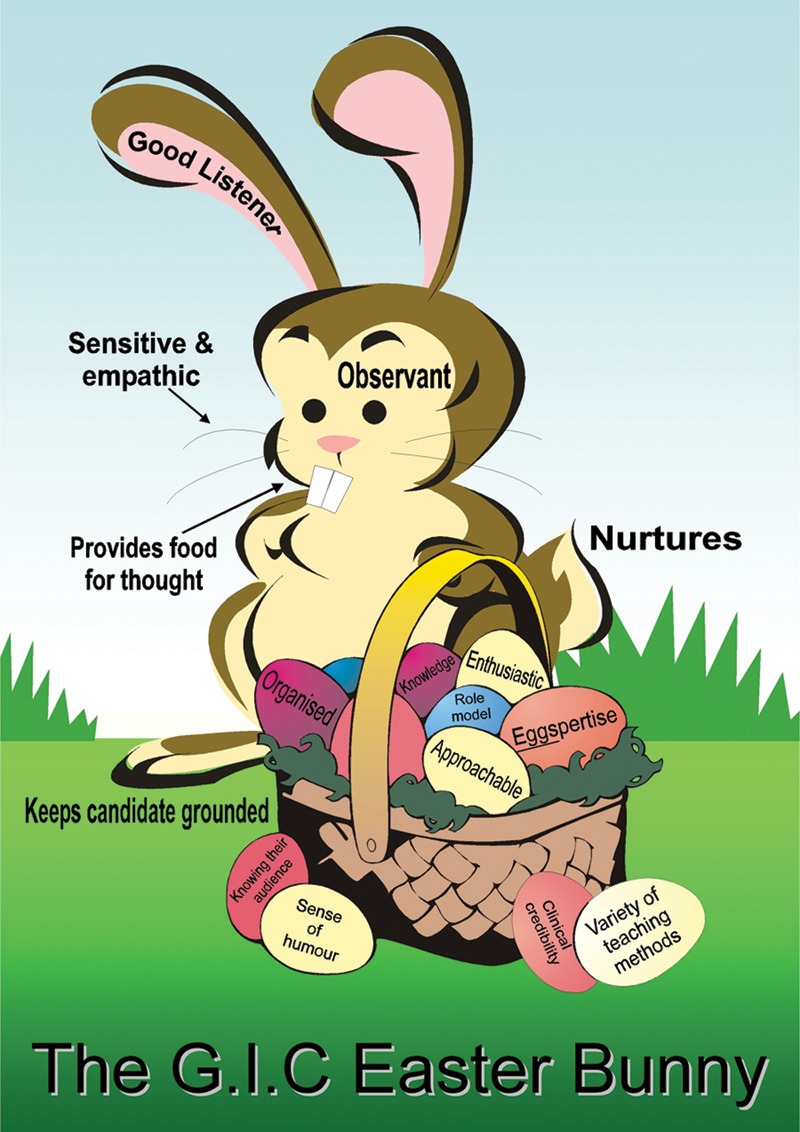
Instructors are like an ‘Easter Bunny’
Figure 5.
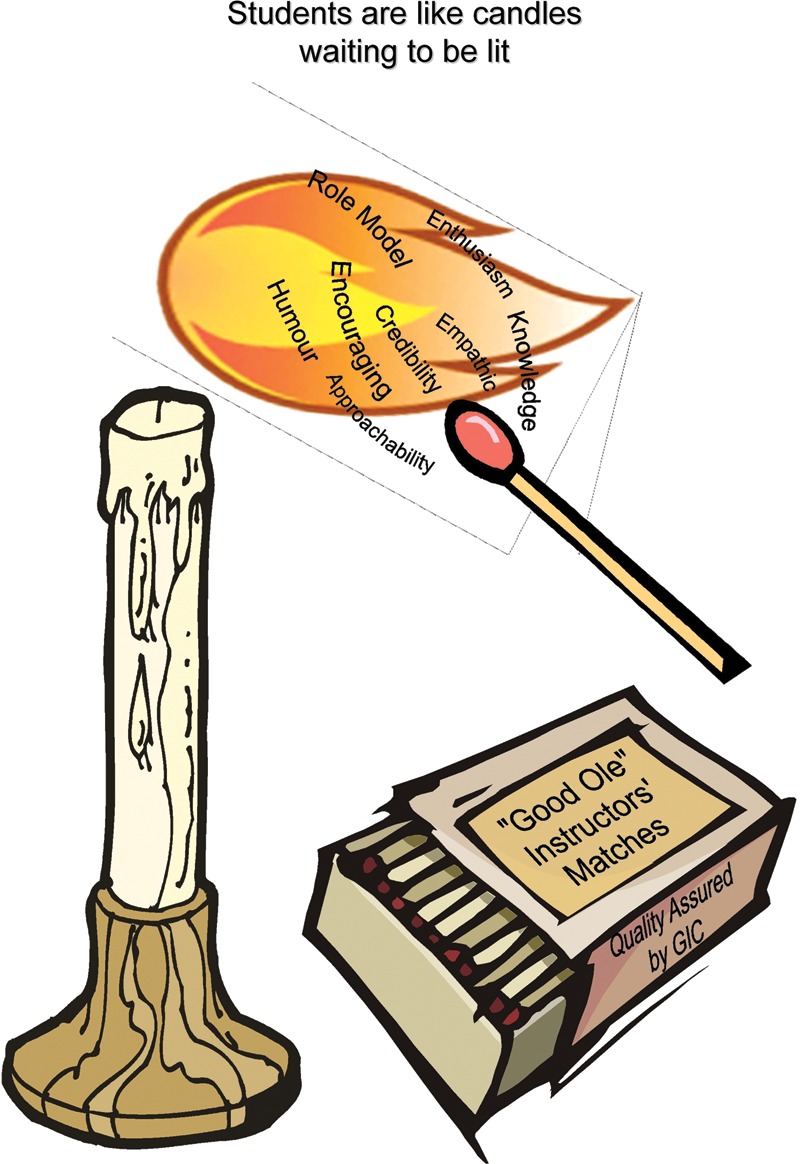
‘Students are like candles to be lit, not vessels to be filled’ – Plutarch
Figure 6.
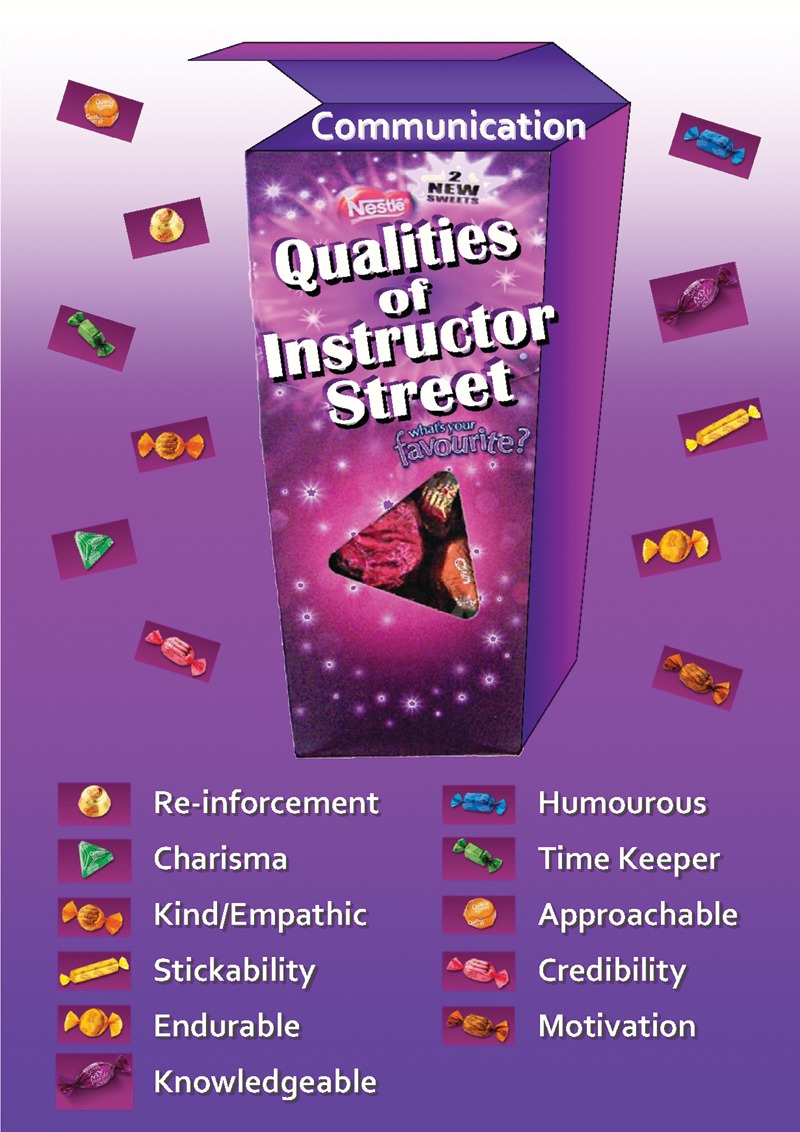
Instructors are like ‘Quality Street’ sweets
Creating the images and permission for images
Generally speaking, it is not difficult to obtain permission to use a picture of a famous painting for teaching purposes and British galleries do not usually charge a fee. Once the title of a chosen painting is identified, enter the title into ‘Google’ and find the art gallery where it is hanging, a contact address and email will usually be apparent.
Purchasing an occasional image which has been professionally edited can be well worth their reasonably small payments. Many reputable sites offer royalty-free images which, once purchased, can be used for teaching purposes. Royalty-free images give exclusive use but may be for a limited time only. Another option is to purchase the right to use an individual image each time it is needed. This latter option is known as ‘rights managed stock’ and a price is negotiated for each use.25 It is important to be aware that permission for oral presentation does not necessarily extend to use in a journal submission. There are web-based galleries which allow you to search for certain artists or topics, or periods of history; some are completely virtual.26 Others are available from the websites of many museums and galleries, and often include excellent search capability such as the Victoria and Albert museum,27 the Metropolitan gallery28 and the John Paul Getty museum.29
Obtaining permission to use a cartoon can be more complex. Artists such ‘Matt’ who work for the Daily Telegraph can be accessed through the newspaper. Other artists have their own web sites for example, Sir Quentin Blake. Requests for permission are usually answered within 3–5 working days. Images within journals are available but tend to be more costly and permission is sought from the publisher, not the author.
When using one's own images, consider carefully the purpose of the image. If there is no text, a picture may fill the whole screen. However, it is more common to want to embed some text. It is best to be selective, use interesting lines, dramatic colours and patterns which lead one's eye into the picture space. The image should follow ‘the rule of thirds’, any dark part of an image should fill no more than one third of the image, similarly text should only occupy one third of the screen and should be positioned over pale areas of the image, the remaining third should be a pale part of the image as illustrated in Figure 7. The aim is clarity and Reynolds5 suggests one should consider whether or not the slides support the dialogue.
Figure 7.
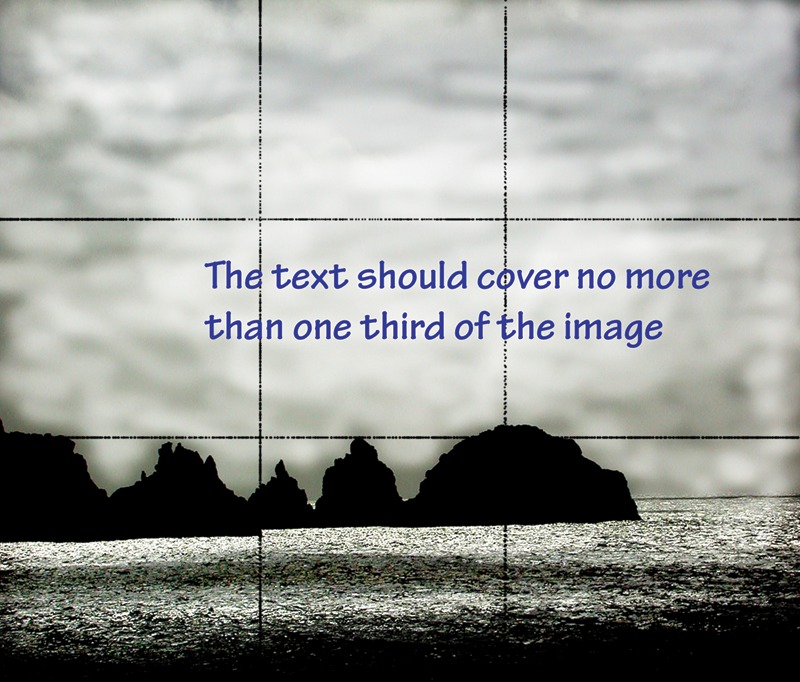
The rule of ‘thirds’
Conclusions
Images can be far more effective in teaching than many teachers appreciate and may allow a significant reduction in text slides. The careful construction of teaching around high quality images augment the effect of the spoken word. Lecturers should practice the timing of their lectures together with the portrayal of their images to provide synchronicity. High quality colour images when accompanied by synchronized verbal information can motivate students, aid understanding and help memory. Careful consideration of how one may make, purchase or gain permission for images can transform teaching and make it much more creative and stimulating.
DECLARATIONS
Competing interests
None declared
Funding
None
Ethical approval
Not applicable
Guarantor
EMN
Contributorship
EMN is the sole contributor
Acknowledgements
None
References
- 1.O'Neill G, Moore S, McMullin B Emerging issues in the practice of university teaching, Resource pack 2. Emerging issues in the practice of University Learning and Teaching. Publisher AISHE, Eire. 2005: http://www.aishe.org/readings/2005-1/toc.html (last accessed 1 March 2010)
- 2.Knowles MS, Holton EF, Swanson RA The Adult Learner 6th Edition. Elsevier, London, 1998 [Google Scholar]
- 3.Martin L The Monroe doctrine: critical thinking through the use of a commemorative coin. Social Studies 2007;98:93–8 [Google Scholar]
- 4.Norvig P PowerPoint: shot with its own bullets. The Lancet 2003;362:343–4 [DOI] [PubMed] [Google Scholar]
- 5.Reynolds G Presentationzen-simple ideas on presentation design and delivery. New Riders, California: 2008 [Google Scholar]
- 6.Gombrich EH The Story of Art. Phaidon Press Ltd, London, 1995 [Google Scholar]
- 7.Mykityshy A, Fisk L, Rogers WA Learning to use a home medical device mediating age related differences with training. Human factors 2002;44:354–4 [DOI] [PubMed] [Google Scholar]
- 8.Cosgrove JF, Fordy K, Nesbitt IDl Thomas the tank engine and friends improve the understanding of oxygen delivery and the pathophysiology of hypoxaemia. Anaesthesia: 2006;61:1069–74 [DOI] [PubMed] [Google Scholar]
- 9.Azer S Twelve tips for creating trigger images for problem-based learning cases. Medical Teacher 2007;29:93–7 [DOI] [PubMed] [Google Scholar]
- 10.Wilkinson LE, Gledhill SR Integrated approach to a teaching file linked to PACS: Journal of digital imaging 2007;20:402–10 [DOI] [PMC free article] [PubMed] [Google Scholar]
- 11.Anglin GJ, Vaez H, Cunningham K Visual representations and learning: the role of static and animated graphics. See http://www.aishe.org/readings/2005-1/ downloaded 1/04/10 2005
- 12.Sadoski M and Paivio A ‘Imagery and Text a dual coding theory of reading and writing’, Erlbaum Assoc, New Jersey: 2001 [Google Scholar]
- 13.Baddeley A, Eysenck MW, Andersson MC Memory, Pyschology Press: New York, 2009 [Google Scholar]
- 14.Anderson JR, Bower GH Human associative memory: revised edition. Hillsdale, Winston & Sons, Washington DC, 1973 [Google Scholar]
- 15.Cendan J, Kim M, Kurenov S, Peters J Developing a multimedia environment for customised teaching of adrenalectomy. Surgical endoscopy:2007;21:1012–16 [DOI] [PubMed] [Google Scholar]
- 16.Doring A The use of cartoons as a teaching and learning strategy. See http://www.tedi.uq.edu.au/Conferences/teach_conference00 (last accessed 29 April 2009)
- 17.Cassady H, Bloomfield RE, Hayward N Relaxed conditions can provide memory cues in both undergraduates and primary school children. British Journal of educational psychology 2002;72:531–47 [DOI] [PubMed] [Google Scholar]
- 18.Novak JD, Canas AJ The theory underlying concept maps and how to construct them 2006 See http://cmap.ihmc.us/publications/researchpapers/theorycmaps/theoLast downloaded 21-02-11
- 19.Richmann KJ Short term memory retention, how time and colour play a role. St Martin's Biology journal 2006;1:51–6 [Google Scholar]
- 20.Click JW, Stempel GH Reader responses to front page with four colour half-tones. Journalism Quarterly 1976; 52:736–8 [Google Scholar]
- 21.Suzuki S, Takahashi Y Effectiveness of colour in picture recognition memory. Japanese psychological research 1997;39:25–32 [Google Scholar]
- 22.Wichmann FA, Sharpe LT, Gegenfurtner KR The contributions of colour to recognition memory for natural scenes. Journal of Experimental Psychology, Learning, Memory and Cognition 2002;28:509–20 See http://institute.nsta.org/scipack_research/AECT_Animated_Graphics_33.pdf-downloaded 1-05-10 [PubMed] [Google Scholar]
- 23.Ericsson KA, Charness N, Feltovich PJ, Hoffman RR The Cambridge handbook of Expertise and Expert performance. Cambridge University Press, New York: 2006 [Google Scholar]
- 24.Finn GM Twelve tips for running a successful body painting teaching session. Medical teacher 2010;32:887–90 [DOI] [PubMed] [Google Scholar]
- 25.www.istockphoto.com (last accessed 23 January 2012)
- 26.See http://www.wga.hu/index1.html (last accessed 25 January 2012)
- 27.See http://www.vam.ac.uk/ (last accessed 23 January 2012)
- 28.www.metmuseum.org (last accessed 23 January 2012)
- 29.See http://www.getty.edu/museum/ (last accessed 23 January 2012)



